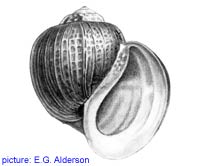|
Pomacea (pomacea)
urceus (Müller, 1774)
|
 Pomacea urceus. (picture not licenced under creative commons) |
 Pomacea urceus. (picture not licenced under creative commons) |
 Pomacea urceus. (picture not licenced under creative commons) |
Shell: very globose; wide and
deep umbilicus; short spine; 125-135 high and 115-125 mm wide.
Colour: yellow, olive-green to black, no spiral banding; white to red columella
(inner lip).
Operculum:
Body:
Eggs and aestivation: Pomacea urceus lives in temporary water
bodies in northern South America where the female lays her egg clutch (50-200
eggs) when the dry season starts (December-Januariy) and which hatch in Januari-Februari
while the mother aestivates. The young snails aetivate for about 4 months in
an incubation chamber between the mother's operculum and the dry mud until the
rain season starts.
Pomacea urceus only burries shallow into the mud during aestivation and
their metabolism remains aerobic (oxygen based), this in contrast with species
as Pila virens, that have
an anaerobic metabolism during aestivation.
One major problem that the aestivating Pomacea urceus faces is overheating
in the sun. Therefore, the snails uses evaporative cooling (comparable with
transpiration in humans) to keep their body temperature below 41°C.
Colour: white; Egg size: 6.7 to 15.5 mm.
Food:
Distribution: British and French Guianas, Venezuela, Colombia, Trinidad, Peru,
Brazil and Equador.
|
Except where otherwise noted, this page is licensed under a Creative Commons Attribution-NonCommercial-ShareAlike 2.5 License . http://www.applesnail.net |
|